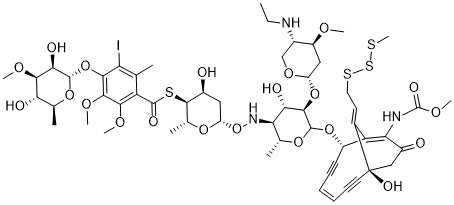| Cas No.: | 108212-75-5 |
| Chemical Name: | Carbamic acid,N-[(1R,4Z,8S,13E)-8-[[4,6-dideoxy-4-[[[2,6-dideoxy-4-S-[4-[(6-deoxy-3-O-methyl-a-L-mannopyranosyl)oxy]-3-iodo-5,6-dimethoxy-2-methylbenzoyl]-4-thio-b-D-ribo-hexopyranosyl]oxy]amino]-2-O-[2,4-dideoxy-4-(ethylamino)-3-O-methyl-a-L-threo-pentopyranosyl]-b-D-glucopyranosyl]oxy]-1-hydroxy-13-[2-(methyltrithio)ethylidene]-11-oxobicyclo[7.3.1]trideca-4,9-diene-2,6-diyn-10-yl]-,methyl ester |
| Synonyms: | Carbamic acid,N-[(1R,4Z,8S,13E)-8-[[4,6-dideoxy-4-[[[2,6-dideoxy-4-S-[4-[(6-deoxy-3-O-methyl-a-L-mannopyranosyl)oxy]-3-iodo-5,6-dimethoxy-2-methylbenzoyl]-4-thio-b-D-ribo-hexopyranosyl]oxy]amino]-2-O-[2,4-dideoxy-4-(ethylamino)-3-O-methyl-a-L-threo-pentopyranosyl]-b-D-glucopyranosyl]oxy]-1-hydroxy-13-[2-(methyltrithio)ethylidene]-11-oxobicyclo[7.3.1]trideca-4,9-diene-2,6-diyn-10-yl]-,methyl ester;Calicheamicin;CALICHEAMICIN GAMMA(1)I;Calicheamicin γ1;Calicheamicin γ1I;Carbamic acid,N-[(1R,4Z,8S,13E)-8-[[4,6-dideoxy-4-[[[2,6-dideoxy-4-S-[4-[(6-deoxy-3-O-methyl-a-L-mannopyranosyl)oxy]-3-iodo-5;Carbamic acid,N-[(1R,4Z,8S,13E)-8-[[4,6-dideoxy-4-[[[2,6-dideoxy-4-S-[4-[(6-deoxy-3-O-methyl-a-L-mannopyranosyl)oxy]-3-iodo-5,6-dimethoxy-2-methylbenzoyl]-4-thio-b-D-ribo-hexopyranosyl]oxy]amino]-2-O-;Benzenecarbothioic acid, 4-((6-deoxy-3-O-methyl-alpha-L-mannopyranosyl)oxy)-3-iodo-5,6-dimethoxy-2-methyl-, 4''-ester with methyl (8-((4,6-dideoxy-2-O-(2,4-dideoxy-4-(ethylamino)-3-O-methyl-alpha-L-threo-pentapyranosyl)-4-(((2,6-dideoxy-4-thio-beta-D-ribo-hexopyranosyl)oxy)amino)-beta-D-glucopyranosyl)oxy)-1-hydroxy-13-(2-(methyltrithio)ethylidene)-11;Calicheamicin gamma(1,I);Calichemicin gamma1;LL-E 33288 gamma1-I;Calicheamicin g1I;calicheamicin gamma;Calicheamicin γ1 purity>95;Carbamic acid, ((1R,4Z,8S,13E)-8-((4,6-dideoxy-4-(((2,6-dideoxy-4-S-(4-((6-deoxy-3-o-methyl-alpha-L-mannopyranopyranosyl)oxy)-3-iodo-5,6-dimethoxy-2-methylbenzoyl)-4-thio-beta-D-ribo-hexopyranosyl)oxy)amino)-2-o-(2,4-dideoxy-4-(ethylamino)-3-o-methyl-alpha-L-threo-pentopyranosyl)-beta-D-glucopyranosyl)oxy)-1-hydroxy-13-(2-(methyltrithio)ethylidene)-11-oxobicyclo(7.3.1)trideca-4,9-diene-2,6-diyn-10-yl)-, methyl ester;Benzenecarbothioic acid, 4-((6-deoxy-3-o-methyl-alpha-L-mannopyranosyl)oxy)-3-iodo-5,6-dimethoxy-2-methyl-, 4''-ester with methyl (8-((4,6-dideoxy-2-o-(2,4-dideoxy-4-(ethylamino)-3-o-methyl-alpha-L-threo-pentapyranosyl)-4-(((2,6-dideoxy-4-thio-beta-D-ribo-hexopyranosyl)oxy)amino)-beta-D-glucopyranosyl)oxy)-1-hydroxy-13-(2-(methyltrithio)ethylidene)-11-oxobicyclo(7.3.1)trideca-4,9-diene-2,6-diyn-10-yl)carbamate, (1R-(1R*,4Z,8S*,13E))- |
| SMILES: | O=C(S[C@@H]1[C@@H](C)O[C@@H](ON[C@@H]2[C@@H](C)OC(O[C@@H](C#C/C=C\C#C[C@@]3(O)C4)C(/C3=C\CSSSC)=C(NC(OC)=O)C4=O)[C@H](O[C@H]5C[C@H](OC)[C@@H](NCC)CO5)[C@H]2O)C[C@@H]1O)C6=C(OC)C(OC)=C(O[C@H]7[C@H](O)[C@H](OC)[C@@H](O)[C@H](C)O7)C(I)=C6C |
| Formula: | C55H74N3O21S4I |
| M.Wt: | 1368.34756 |
| Purity: | >98% |
| Sotrage: | 2 years -20°C Powder, 2 weeks 4°C in DMSO, 6 months -80°C in DMSO |
| Description: | Calicheamicin is a cytotoxic agent that causes double-strand DNA breaks. |
| In Vivo: | An ADC comprising a humanized anti-EFNA4 monoclonal antibody conjugated to the DNA-damaging agent calicheamicin achieves sustained tumor regressions in both TNBC and ovarian cancer PDX in vivo. PF-06647263 (0.27, 0.36 mg/kg) results in significant tumor regressions in TNBC xenografts[1]. |
| In Vitro: | PF-06647263 (anti-EFNA4-ADC) is generated via conjugation of hE22 lysine residues to the AcButDMH-N-Ac-calicheamicin-γ1 linker-payload with an average drug-to-antibody ratio (DAR) of 4.6. PF-06647263 elicits antigen- and concentration-dependent cytotoxicity, as exposure to PF-06647263 for 96 hours results in cell death (EC50= appr 1 ng/mL)[1]. CMC-544, consisting of a humanized CD22 Ab linked to calicheamicin, is effective in pediatric primary B-cell precursor acute lymphoblastic leukemia (BCP-ALL) cells in vitro. CMC-544 induces cell death in various ALL cell lines in a dose- and time-dependent way, with IC50 values ranging from 0.15 to 4.9 ng/mL. CMC-544 (10 ng/mL) is effective and specific in primary BCP-ALL cells[2]. In CMC-544-treated cells, the level of CD22 has decreased relative to that on G5/44-treated cells and continued to decrease[3]. |
| Cell Assay: | The enhancement of the CDC effect is studied in a similar way in the presence of CMC-544 or G5/44. Specifically, after cells are incubated with or without CMC-544 (5 ng/mL calichemicin DMH) or G5/44 at 37°C for 2 h, they are washed three times to remove unbound antibodies. The viability of cells before incubation with CMC-544 is 99.8%. After the cells are re-incubated in CMC-544- and rituximab-free medium at 37°C for 0-48 h, CDC is analyzed. |
| Animal Administration: | Cohorts of tumor-bearing mice (140-180 mm3) are randomized into study groups of 6 to 10 based on the number of available mice. The IDBS electronic notebook statistical package, Biobook, is used for automated animal randomization. Animals are dosed by intraperitoneal injection (or intravenously for 144580) twice a week for 4 cycles with ADC, or once a week for 2 cycles with 1.5 mg/kg doxorubicin for breast PDX tumors or 5 mg/kg Cisplatin for ovarian PDX. Study groups are followed until either individual mice or entire cohort measurements reach 1,200 mm3, at which point sacrifice is indicated. Tumor regression is defined as a reduction in mean tumor volume after dosing. In cases where tumors regress, time to progression (TTP) is determined to be the number of days between the first dose and the time at which mean tumor volume significantly increase (regrow) after regression. |
| References: | [1]. Damelin M, et al. Anti-EFNA4 Calicheamicin Conjugates Effectively Target Triple-Negative Breast and Ovarian Tumor-Initiating Cells to Result in Sustained Tumor Regressions. Clin Cancer Res. 2015 Sep 15;21(18):4165-73 [2]. de Vries JF, et al. The novel calicheamicin-conjugated CD22 antibody inotuzumab ozogamicin (CMC-544) effectively kills primary pediatric acute lymphoblastic leukemia cells. Leukemia. 2012 Feb;26(2):255-64 [3]. Takeshita A, et al. CMC-544 (inotuzumab ozogamicin), an anti-CD22 immuno-conjugate of calicheamicin, alters the levels of target molecules of malignant B-cells. Leukemia. 2009 Jul;23(7):1329-36. |






















